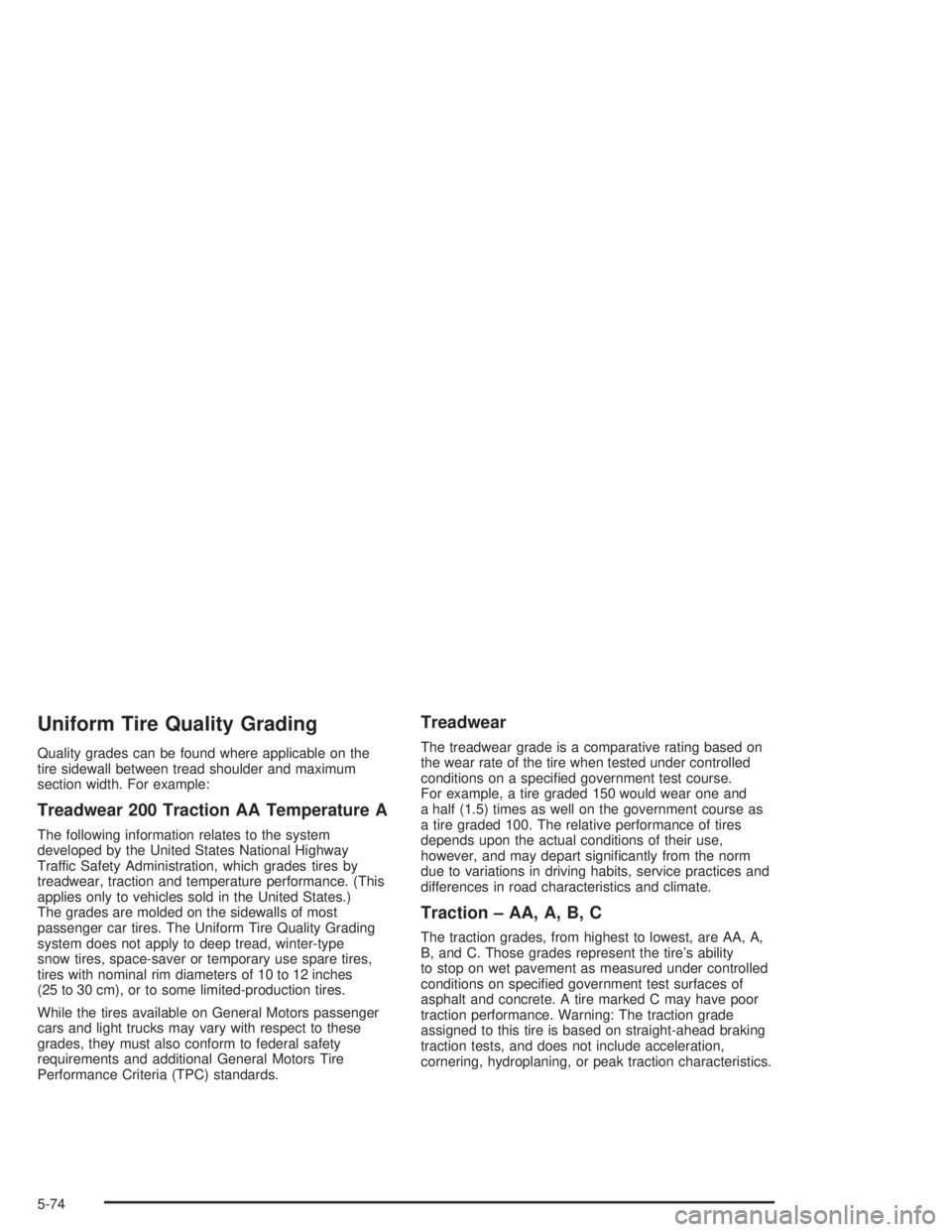2004 PONTIAC GRAND PRIX Tire uniform grading
[x] Cancel search: Tire uniform gradingPage 281 of 432

Service............................................................5-3
Doing Your Own Service Work.........................5-3
Adding Equipment to the Outside
of Your Vehicle...........................................5-4
Fuel................................................................5-4
Gasoline Octane............................................5-4
Gasoline Speci®cations....................................5-5
California Fuel...............................................5-5
Additives.......................................................5-6
Fuels in Foreign Countries...............................5-7
Filling Your Tank............................................5-7
Filling a Portable Fuel Container.....................5-10
Checking Things Under the Hood....................5-10
Hood Release..............................................5-11
Engine Compartment Overview.......................5-12
Engine Oil...................................................5-16
Supercharger Oil..........................................5-21
Engine Air Cleaner/Filter................................5-22
Automatic Transaxle Fluid..............................5-24
Engine Coolant.............................................5-26
Radiator Pressure Cap..................................5-29
Engine Overheating.......................................5-29
Cooling System............................................5-32
Power Steering Fluid.....................................5-42
Windshield Washer Fluid................................5-43Brakes........................................................5-45
Battery........................................................5-48
Jump Starting...............................................5-49
Headlamp Aiming...........................................5-56
Bulb Replacement..........................................5-59
Halogen Bulbs..............................................5-59
Headlamps and Sidemarker Lamps.................5-60
Front Turn Signal, Parking and
Fog Lamps...............................................5-62
Center High-Mounted Stoplamp (CHMSL).........5-64
Taillamps, Turn Signal, and Stoplamps............5-64
Back-Up Lamps............................................5-65
Replacement Bulbs.......................................5-66
Windshield Wiper Blade Replacement..............5-67
Tires..............................................................5-68
In¯ation -- Tire Pressure................................5-69
Tire Pressure Monitor System.........................5-70
Tire Inspection and Rotation...........................5-71
When It Is Time for New Tires.......................5-72
Buying New Tires.........................................5-73
Uniform Tire Quality Grading..........................5-74
Wheel Alignment and Tire Balance..................5-75
Wheel Replacement......................................5-75
Tire Chains..................................................5-77
Section 5 Service and Appearance Care
5-1
Page 354 of 432

Uniform Tire Quality Grading
Quality grades can be found where applicable on the
tire sidewall between tread shoulder and maximum
section width. For example:
Treadwear 200 Traction AA Temperature A
The following information relates to the system
developed by the United States National Highway
Traffic Safety Administration, which grades tires by
treadwear, traction and temperature performance. (This
applies only to vehicles sold in the United States.)
The grades are molded on the sidewalls of most
passenger car tires. The Uniform Tire Quality Grading
system does not apply to deep tread, winter-type
snow tires, space-saver or temporary use spare tires,
tires with nominal rim diameters of 10 to 12 inches
(25 to 30 cm), or to some limited-production tires.
While the tires available on General Motors passenger
cars and light trucks may vary with respect to these
grades, they must also conform to federal safety
requirements and additional General Motors Tire
Performance Criteria (TPC) standards.
Treadwear
The treadwear grade is a comparative rating based on
the wear rate of the tire when tested under controlled
conditions on a speci®ed government test course.
For example, a tire graded 150 would wear one and
a half (1.5) times as well on the government course as
a tire graded 100. The relative performance of tires
depends upon the actual conditions of their use,
however, and may depart signi®cantly from the norm
due to variations in driving habits, service practices and
differences in road characteristics and climate.
Traction ± AA, A, B, C
The traction grades, from highest to lowest, are AA, A,
B, and C. Those grades represent the tire's ability
to stop on wet pavement as measured under controlled
conditions on speci®ed government test surfaces of
asphalt and concrete. A tire marked C may have poor
traction performance. Warning: The traction grade
assigned to this tire is based on straight-ahead braking
traction tests, and does not include acceleration,
cornering, hydroplaning, or peak traction characteristics.
5-74
Page 430 of 432

Throttle System Inspection...............................6-15
Tilt Wheel........................................................ 3-5
Tire In¯ation Check.........................................6-10
Tires.............................................................5-68
Buying New Tires........................................5-73
Chains.......................................................5-77
Changing a Flat Tire....................................5-78
Compact Spare Tire.....................................5-89
If a Tire Goes Flat.......................................5-78
In¯ation -- Tire Pressure...............................5-69
Inspection and Rotation................................5-71
Pressure Monitor System..............................5-70
Uniform Tire Quality Grading.........................5-74
Wheel Alignment and Tire Balance.................5-75
Wheel Replacement.....................................5-75
When It Is Time for New Tires......................5-72
To Use the Engine Coolant Heater....................2-21
Top Strap......................................................1-39
Top Strap Anchor Location...............................1-40
Torque Lock...................................................2-29
Total Weight on Your Vehicle's Tires..................4-39
Towing
Recreational Vehicle.....................................4-33
Towing a Trailer..........................................4-37
Your Vehicle...............................................4-33
Traction
Control System (TCS)..................................4-10
Control System Warning Light.......................3-38
Enhanced Traction System (ETS)...................4-11Traction (cont.)
Enhanced Traction System (ETS)
Warning Light..........................................3-38
Stabilitrak
ž& Plus System.............................4-13
TRACTION CONTROL ACTIVE.........................3-87
TRACTION CONTROL OFF.............................3-87
Trailer Brakes.................................................4-40
Transaxle
Fluid, Automatic...........................................5-24
Transaxle Operation, Automatic.........................2-22
Transmission
Up-Shift Light..............................................3-35
Transmission, Transaxle, Transfer Case Unit
Repair Manual............................................7-10
Transportation Options...................................... 7-8
Trunk............................................................2-10
Trunk Assist Handle........................................2-11
Trunk Lock....................................................2-10
Turn and Lane-Change Signals.........................3-14
TURN SIGNAL ON.........................................3-87
Turn Signals When Towing a Trailer..................4-42
U
Underbody Flushing Service.............................6-13
Underhood Fuse Block...................................5-102
Understanding Radio Reception.......................3-130
Uniform Tire Quality Grading............................5-74
14